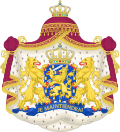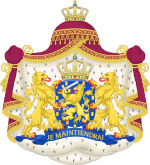Dutch Monarchy
| King of the Netherlands | |
|---|---|
| Koning der Nederlanden | |

|
|
| Incumbent | |
|
Willem-Alexander since 30 April 2013 |
|
| Details | |
| Style | His Majesty |
| Heir apparent | Catharina-Amalia, Princess of Orange |
| First monarch | William I |
| Formation | 16 March 1815 |
| Residence |
Royal Palace of Amsterdam Noordeinde Palace Huis ten Bosch |
| Website | The Royal Website |
| Dutch royal family |
|---|
 |
Extended royal family
* Member of the Dutch royal house
|
The monarchy of the Netherlands is constitutional and as such, the role and position of the monarch are defined and limited by the constitution of the Netherlands. Consequently, a fairly large portion of the Dutch constitution is devoted to the monarch; roughly a third of the constitution describes the succession, mechanisms of accession and abdication to the throne, the roles and responsibilities of the monarch and the formalities of communication between the States-General of the Netherlands and the role of the monarch in the creation of laws.
The Kingdom of the Netherlands has been an independent monarchy since 16 March 1815, but its one-time sovereign provinces have intermittently been "governed" by members of the House of Orange-Nassau and the House of Nassau from 1559 to 1747, since Philip II of Spain appointed William of Orange as stadtholder. William became the leader of the Dutch Revolt and the independent Dutch Republic. As stadtholder, he was followed by several of his descendants. In 1747, the function of stadtholder became a hereditary position in all Provinces of the thus "crowned" Dutch Republic. The last stadtholder was William V. His son William I, became the first king.
The cycle of monarchs is described in the first section of Chapter 2 of the constitution, which is dedicated to the government of the Netherlands.
...
Wikipedia
